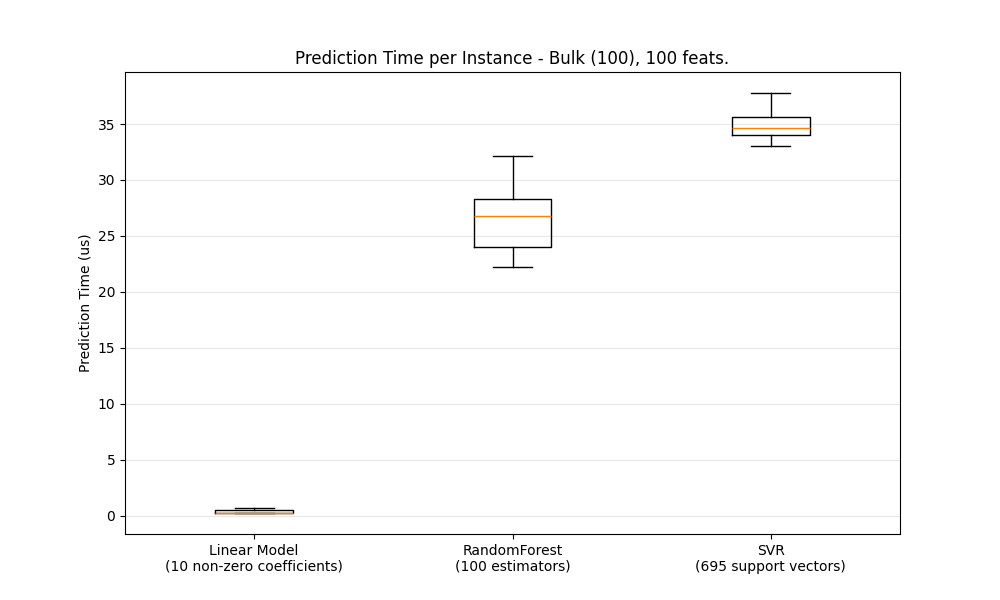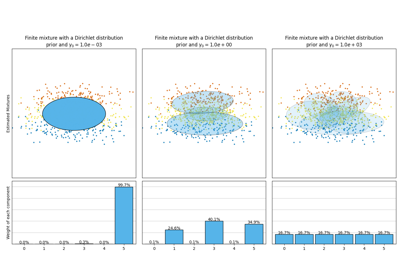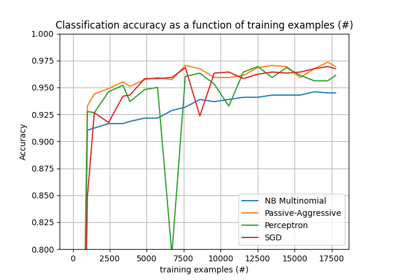Note
Go to the end to download the full example code. or to run this example in your browser via Binder
预测延迟#
这是一个展示各种scikit-learn估计器预测延迟的示例。
目标是测量在批量或原子(即一个接一个)模式下进行预测时可以预期的延迟。
图表以箱线图的形式表示预测延迟的分布。
# 作者:scikit-learn 开发者
# SPDX许可证标识符:BSD-3-Clause
import gc
import time
from collections import defaultdict
import matplotlib.pyplot as plt
import numpy as np
from sklearn.datasets import make_regression
from sklearn.ensemble import RandomForestRegressor
from sklearn.linear_model import Ridge, SGDRegressor
from sklearn.model_selection import train_test_split
from sklearn.preprocessing import StandardScaler
from sklearn.svm import SVR
from sklearn.utils import shuffle
def _not_in_sphinx():
# 检测我们是否由sphinx构建器运行的黑客方法
return "__file__" in globals()
基准测试和绘图辅助函数#
def atomic_benchmark_estimator(estimator, X_test, verbose=False):
"""测量每个实例的运行时间预测。"""
n_instances = X_test.shape[0]
runtimes = np.zeros(n_instances, dtype=float)
for i in range(n_instances):
instance = X_test[[i], :]
start = time.time()
estimator.predict(instance)
runtimes[i] = time.time() - start
if verbose:
print(
"atomic_benchmark runtimes:",
min(runtimes),
np.percentile(runtimes, 50),
max(runtimes),
)
return runtimes
def bulk_benchmark_estimator(estimator, X_test, n_bulk_repeats, verbose):
"""测量整个输入的运行时间预测。"""
n_instances = X_test.shape[0]
runtimes = np.zeros(n_bulk_repeats, dtype=float)
for i in range(n_bulk_repeats):
start = time.time()
estimator.predict(X_test)
runtimes[i] = time.time() - start
runtimes = np.array(list(map(lambda x: x / float(n_instances), runtimes)))
if verbose:
print(
"bulk_benchmark runtimes:",
min(runtimes),
np.percentile(runtimes, 50),
max(runtimes),
)
return runtimes
def benchmark_estimator(estimator, X_test, n_bulk_repeats=30, verbose=False):
"""测量预测在原子模式和批量模式下的运行时间。
Parameters
----------
estimator : 已经训练好的支持 `predict()` 的估计器
X_test : 测试输入
n_bulk_repeats : 评估批量模式时重复的次数
Returns
-------
atomic_runtimes, bulk_runtimes : 一对 `np.array` ,包含以秒为单位的运行时间。
"""
atomic_runtimes = atomic_benchmark_estimator(estimator, X_test, verbose)
bulk_runtimes = bulk_benchmark_estimator(estimator, X_test, n_bulk_repeats, verbose)
return atomic_runtimes, bulk_runtimes
def generate_dataset(n_train, n_test, n_features, noise=0.1, verbose=False):
"""生成具有给定参数的回归数据集。"""
if verbose:
print("generating dataset...")
X, y, coef = make_regression(
n_samples=n_train + n_test, n_features=n_features, noise=noise, coef=True
)
random_seed = 13
X_train, X_test, y_train, y_test = train_test_split(
X, y, train_size=n_train, test_size=n_test, random_state=random_seed
)
X_train, y_train = shuffle(X_train, y_train, random_state=random_seed)
X_scaler = StandardScaler()
X_train = X_scaler.fit_transform(X_train)
X_test = X_scaler.transform(X_test)
y_scaler = StandardScaler()
y_train = y_scaler.fit_transform(y_train[:, None])[:, 0]
y_test = y_scaler.transform(y_test[:, None])[:, 0]
gc.collect()
if verbose:
print("ok")
return X_train, y_train, X_test, y_test
def boxplot_runtimes(runtimes, pred_type, configuration):
"""绘制一个包含预测运行时间箱线图的新 `Figure` 。
Parameters
----------
runtimes : 以微秒为单位的延迟 `np.array` 列表
cls_names : 生成运行时间的估计器类名列表
pred_type : 'bulk' 或 'atomic'
"""
fig, ax1 = plt.subplots(figsize=(10, 6))
bp = plt.boxplot(
runtimes,
)
cls_infos = [
"%s\n(%d %s)"
% (
estimator_conf["name"],
estimator_conf["complexity_computer"](estimator_conf["instance"]),
estimator_conf["complexity_label"],
)
for estimator_conf in configuration["estimators"]
]
plt.setp(ax1, xticklabels=cls_infos)
plt.setp(bp["boxes"], color="black")
plt.setp(bp["whiskers"], color="black")
plt.setp(bp["fliers"], color="red", marker="+")
ax1.yaxis.grid(True, linestyle="-", which="major", color="lightgrey", alpha=0.5)
ax1.set_axisbelow(True)
ax1.set_title(
"Prediction Time per Instance - %s, %d feats."
% (pred_type.capitalize(), configuration["n_features"])
)
ax1.set_ylabel("Prediction Time (us)")
plt.show()
def benchmark(configuration):
"""运行整个基准测试。"""
X_train, y_train, X_test, y_test = generate_dataset(
configuration["n_train"], configuration["n_test"], configuration["n_features"]
)
stats = {}
for estimator_conf in configuration["estimators"]:
print("Benchmarking", estimator_conf["instance"])
estimator_conf["instance"].fit(X_train, y_train)
gc.collect()
a, b = benchmark_estimator(estimator_conf["instance"], X_test)
stats[estimator_conf["name"]] = {"atomic": a, "bulk": b}
cls_names = [
estimator_conf["name"] for estimator_conf in configuration["estimators"]
]
runtimes = [1e6 * stats[clf_name]["atomic"] for clf_name in cls_names]
boxplot_runtimes(runtimes, "atomic", configuration)
runtimes = [1e6 * stats[clf_name]["bulk"] for clf_name in cls_names]
boxplot_runtimes(runtimes, "bulk (%d)" % configuration["n_test"], configuration)
def n_feature_influence(estimators, n_train, n_test, n_features, percentile):
"""估计特征数量对预测时间的影响。
Parameters
----------
estimators : 用于基准测试的(名称(str),估计器)字典
n_train : 训练实例的数量(int)
n_test : 测试实例的数量(int)
n_features : 要测试的特征空间维度列表(int)
percentile : 测量速度的百分位数(int [0-100])
Returns:
--------
percentiles : 字典(估计器名称,
字典(特征数量,百分位性能(微秒)))
"""
percentiles = defaultdict(defaultdict)
for n in n_features:
print("benchmarking with %d features" % n)
X_train, y_train, X_test, y_test = generate_dataset(n_train, n_test, n)
for cls_name, estimator in estimators.items():
estimator.fit(X_train, y_train)
gc.collect()
runtimes = bulk_benchmark_estimator(estimator, X_test, 30, False)
percentiles[cls_name][n] = 1e6 * np.percentile(runtimes, percentile)
return percentiles
def plot_n_features_influence(percentiles, percentile):
fig, ax1 = plt.subplots(figsize=(10, 6))
colors = ["r", "g", "b"]
for i, cls_name in enumerate(percentiles.keys()):
x = np.array(sorted(percentiles[cls_name].keys()))
y = np.array([percentiles[cls_name][n] for n in x])
plt.plot(
x,
y,
color=colors[i],
)
ax1.yaxis.grid(True, linestyle="-", which="major", color="lightgrey", alpha=0.5)
ax1.set_axisbelow(True)
ax1.set_title("Evolution of Prediction Time with #Features")
ax1.set_xlabel("#Features")
ax1.set_ylabel("Prediction Time at %d%%-ile (us)" % percentile)
plt.show()
def benchmark_throughputs(configuration, duration_secs=0.1):
"""不同估计器的基准吞吐量。"""
X_train, y_train, X_test, y_test = generate_dataset(
configuration["n_train"], configuration["n_test"], configuration["n_features"]
)
throughputs = dict()
for estimator_config in configuration["estimators"]:
estimator_config["instance"].fit(X_train, y_train)
start_time = time.time()
n_predictions = 0
while (time.time() - start_time) < duration_secs:
estimator_config["instance"].predict(X_test[[0]])
n_predictions += 1
throughputs[estimator_config["name"]] = n_predictions / duration_secs
return throughputs
def plot_benchmark_throughput(throughputs, configuration):
fig, ax = plt.subplots(figsize=(10, 6))
colors = ["r", "g", "b"]
cls_infos = [
"%s\n(%d %s)"
% (
estimator_conf["name"],
estimator_conf["complexity_computer"](estimator_conf["instance"]),
estimator_conf["complexity_label"],
)
for estimator_conf in configuration["estimators"]
]
cls_values = [
throughputs[estimator_conf["name"]]
for estimator_conf in configuration["estimators"]
]
plt.bar(range(len(throughputs)), cls_values, width=0.5, color=colors)
ax.set_xticks(np.linspace(0.25, len(throughputs) - 0.75, len(throughputs)))
ax.set_xticklabels(cls_infos, fontsize=10)
ymax = max(cls_values) * 1.2
ax.set_ylim((0, ymax))
ax.set_ylabel("Throughput (predictions/sec)")
ax.set_title(
"Prediction Throughput for different estimators (%d features)"
% configuration["n_features"]
)
plt.show()
基准测试各种回归器的大量/原子预测速度#
configuration = {
"n_train": int(1e3),
"n_test": int(1e2),
"n_features": int(1e2),
"estimators": [
{
"name": "Linear Model",
"instance": SGDRegressor(
penalty="elasticnet", alpha=0.01, l1_ratio=0.25, tol=1e-4
),
"complexity_label": "non-zero coefficients",
"complexity_computer": lambda clf: np.count_nonzero(clf.coef_),
},
{
"name": "RandomForest",
"instance": RandomForestRegressor(),
"complexity_label": "estimators",
"complexity_computer": lambda clf: clf.n_estimators,
},
{
"name": "SVR",
"instance": SVR(kernel="rbf"),
"complexity_label": "support vectors",
"complexity_computer": lambda clf: len(clf.support_vectors_),
},
],
}
benchmark(configuration)
Benchmarking SGDRegressor(alpha=0.01, l1_ratio=0.25, penalty='elasticnet', tol=0.0001)
Benchmarking RandomForestRegressor()
Benchmarking SVR()
基准测试 n_features 对预测速度的影响#
percentile = 90
percentiles = n_feature_influence(
{"ridge": Ridge()},
configuration["n_train"],
configuration["n_test"],
[100, 250, 500],
percentile,
)
plot_n_features_influence(percentiles, percentile)
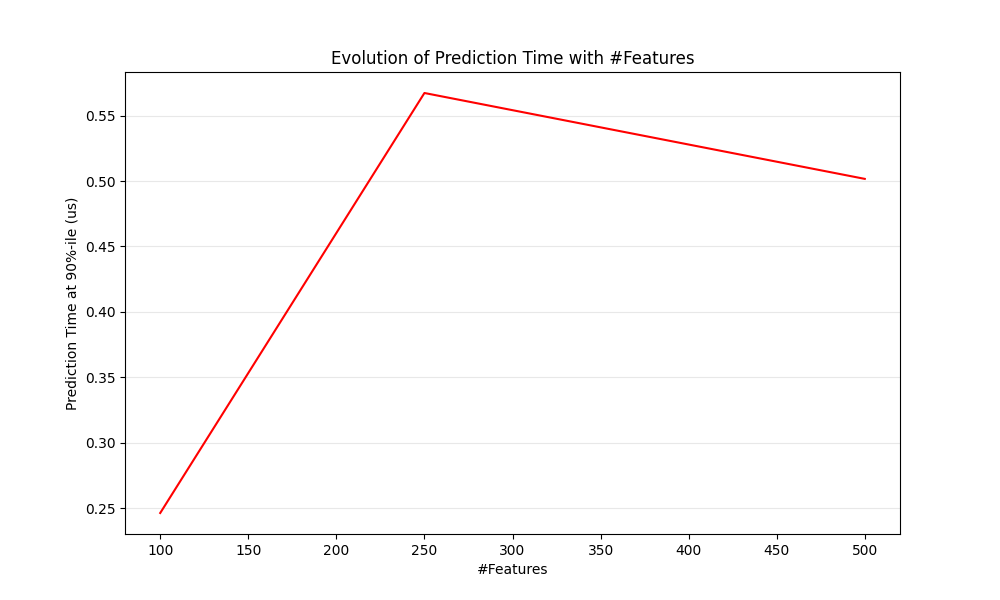
benchmarking with 100 features
benchmarking with 250 features
benchmarking with 500 features
基准吞吐量#
throughputs = benchmark_throughputs(configuration)
plot_benchmark_throughput(throughputs, configuration)
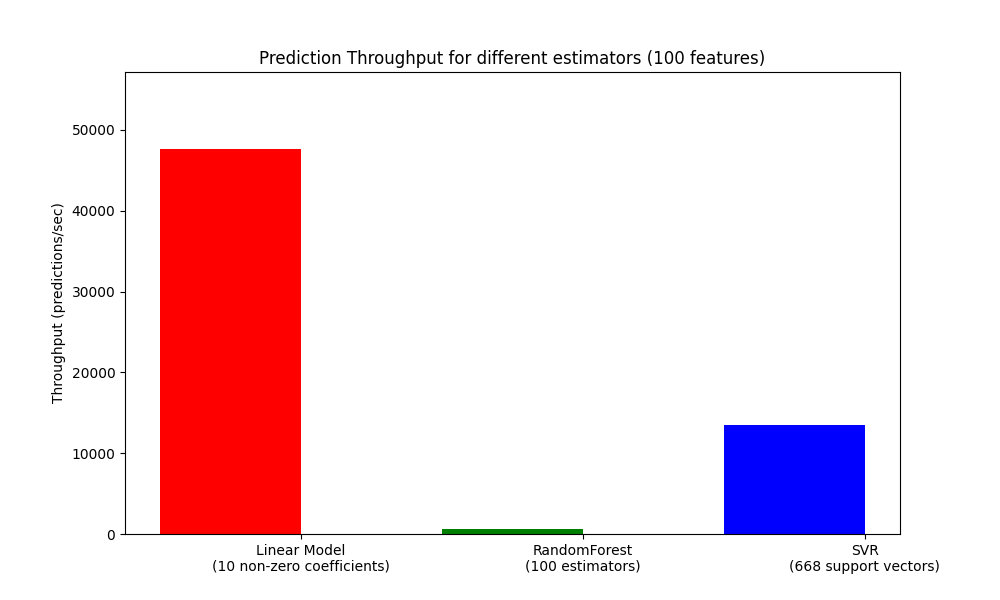
Total running time of the script: (0 minutes 28.432 seconds)
Related examples


